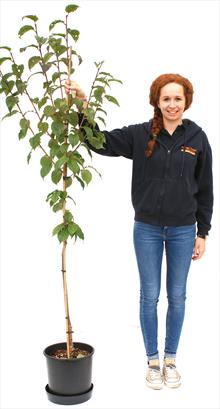Collingwood Ingram
PrunusCollingwood Ingram is an outstanding small flowering cherry tree, and a perfect choice for the smaller garden.
The main attraction is the profusion of dusky deep pink blossom, which arrives in early spring ahead of the leaves.
In autumn the leaves turn orange, providing a further splash of colour in the garden.
Collingwood Ingram flowering cherry trees for sale

All our pot-grown trees are grown for us to our specification by the Frank P Matthews nursery.
All pot-grown trees are suitable for planting out in the garden, some are suitable for growing in containers.
2-year pot-grown
tree
£73.00Grown for us by Frank P Matthews nurseryIn a 12L pot
Small size (1.5m-2.5m after 10 years)
Out of stock
Sorry we have sold out for this season
How to grow
Collingwood Ingram is susceptible to cherry leaf spot (Blumeriella jaapii) which causes small dark red spots on the leaves. This infection is sometimes known as "shot hole" in fruiting cherries, but does not seem to affect flowering cherries as severely. Infections are more prevalent in areas with warm wet spring weather. Infection can be minimised or avoided altogether by the simple precaution of clearing up dead leaves in the autumn, which is where the fungus which causes the infection over-winters.
History
This cherry is named after Captain Collingwood Ingram, an English enthusiast of Japanese flowering cherries. During the first half of the 20th century he was responsible for introducing a large number of ornamental cherries from China and Japan to western gardeners.
Prunus Collingwood Ingram is a seedling of Prunus Kursar, and therefore essentially a form of Prunus campanulata - the Formosan Cherry. Its small compact upright shape and dark pink blossom are both characteristic of this species. It can be perhaps considered an improved form of Kursar - although Kursar is itself one of the most outstanding small flowering cherries.
Collingwood Ingram characteristics
- Gardening skillBeginner
- AwardsRHS AGM (current) - 2012
- Attractive featuresAttractive flowersAutumn foliage colour
- Growth habitUpright
- Height after 10 years1.5m-2.5m / 5ft-8ft
- PruningLight prune
- Growth rateAverage
- Flower colourPink - dark
- Flower formSingle flower (5-8 petals)
- Flowering monthMarch
- Leaf colourGreen
- Leaf colour - autumnMultiple tints
- Country of originUnited Kingdom
- Annual cycleDeciduous
Similar varieties
Prunus campanulataFelix JuryFelix Jury is a form of the Formosan cherry, featuring crimson pink blossom in early spring.
PrunusKursarA small ornamental early-flowing cherry tree, with profuse blossom.
What will it look like?
Illustrative example of a pot-grown tree of this variety as supplied.
Approximate girth: 6/8cm. We try to keep all pot-grown trees down to about 1.5m as supplied, but some may be larger.
Trees should reach their mature height after about 10 or more years.

How to choose a flowering cherry tree
We list more than 70 different flowering cherry trees. Choosing can be difficult! Our article explaining the different characteristics of flowering cherries might help narrow down the selection.
 Over 400 varieties of flowering cherries, crab apples, rowans and other ornamental trees.
Over 400 varieties of flowering cherries, crab apples, rowans and other ornamental trees.